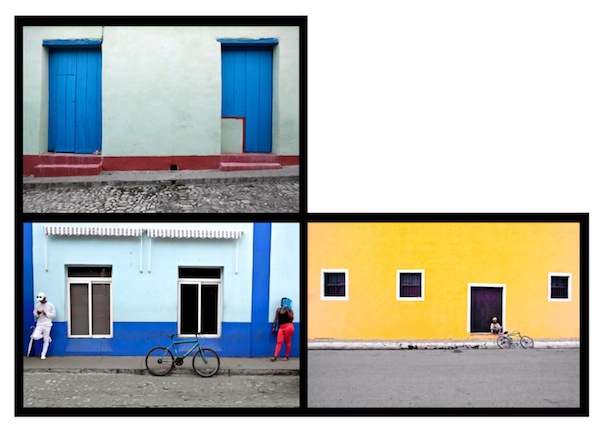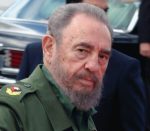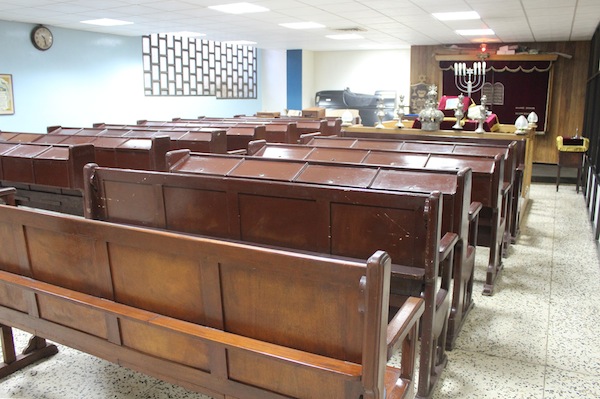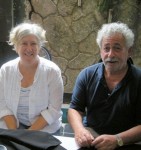Lorne Greenberg’s solo show, Cuba, comprises photographic compositions, such as this one. (photos by Lorne Greenberg)
The origins of Lorne Greenberg’s solo photography exhibition Cuba can be traced back more than 35 years. “I had my MFA in photography from the University of Arizona in 1983,” he told the Independent. “In 1984, I began photographing Mexican street art.”
At first, he photographed on the American side of the border, but later visited Mexico several times, taking pictures of streets and buildings in many Mexican border towns. “I have an affinity for Latin American art,” he said. “I also read many Latin American writers.”
After a few years, though, Greenberg turned his artistic eye to other interests and new subjects. He only started refocusing on Mexico five years ago.
“In 2014, I began to photograph in Mexico again,” he said. “This time, I was interested in streets, buildings and yards, objects as artifacts of culture. I see it as the archeology of Man, a study of Man in his environment through the observance of objects and artifacts. There is no sky in my Mexican photos, but walls and doors and windows. Colours, shapes and lines, and where things are in relation to each other.”
He wanted to dig deeper in that direction, but, having been in Mexico multiple times, he turned to Cuba. “I had never been to Cuba before. I wanted to see it,” he said. “I heard that [Barack] Obama was going there, and I decided that I’d better go before Americanization.”
In spring 2016, Greenberg flew to Cuba for the first time. “Just me, my camera and my backpack. I came a few days after Obama left. I was there for about 10 days and visited three cities: Havana, Santa Clara and Trinidad.”
He wandered the streets and photographed doors and walls and windows, but with a new mode of expression. “I started seeing people,” he said. “Before, there were hardly any people in my photos. Now, I wanted to photograph them as part of the streetscape.”
He continued his Cuban exploration in 2018, on his second trip to the country. This time, he stayed exclusively in Havana. “When I was there, I ate, slept, photographed and listened to jazz,” he recalled. “It’s a vibrant place, with music a prevalent part of life.”
Again, he roamed the streets, without a plan, photographing houses and people. “Nothing is staged in my photos; nobody posed,” he said. “I just waited until I had a perfect image, and then I took it. I wasn’t trying to make a statement, didn’t have any preconceived idea. I just wanted to find what is there, discover the relationship between people and places, the coherence of individuals and their building backdrops. If some people didn’t want to be photographed, they would say it, and I didn’t take their pictures, but that happened only three times.”
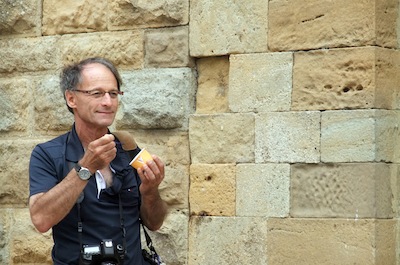
In selecting the images to include in his solo show, from the hundreds he took in Cuba, he said, “I didn’t want to show just 10 or 15 large pictures. A single large image has a privileged status, and I wanted to create an experience of Cuba, to show people what I saw.”
Therefore, he compiled his photographs into compositions, which made it possible to increase the number of different images on display. Each composition is more than a collection of individual photos – it is a work of art on its own.
“There are 102 different pictures in the show, combined into eight compositions,” Greenberg said. “At first, I considered each composition as a tic-tac-toe grid, but it didn’t work. It was too orderly, too tight, didn’t give the sense of Cuba. Then I thought about the sculptures of Alexander Calder. I changed the layout of my compositions, opened them up, created a flow. They are not individual photographs anymore. They are installations, and they incorporate the gallery space as part of the experience. Each composition has a certain colour scheme, and its lines and shapes create a whole, simultaneously dynamic and static, random and structured.”
The arrangement of the compositions was as creative an endeavour as was taking photographs. “It was fun moving pictures around, seeing different possibilities. I could have done it for much longer, if I didn’t have a deadline for the show,” he joked.
Greenberg’s Cuban compositions reflect the political reality of the country. The lively colours of the buildings preen under the heat and light of the sun, while simultaneously exposing the peeling paint, dirty or moldy walls, and the rusty metal of fences and shutters, which hint at the poverty that exists in the country.
“I see beauty, aesthetics and humanity,” said Greenberg. “Poverty is more in the ethical dimension, and everything for me is in the aesthetic world.”
The show Cuba opened on Oct. 24 at the Zack Gallery and continues until Nov. 24. The opening reception was held on Oct 30. For more information on Greenberg’s work, visit lornegreenbergphotography.ca.
Olga Livshin is a Vancouver freelance writer. She can be reached at olgagodim@gmail.com.

